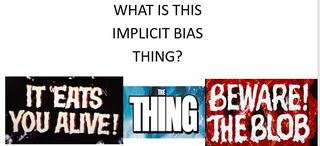Bias
Is Implicit Bias Training Useless?
Training programs make claims that are not justified by research.
Posted June 13, 2021 Reviewed by Gary Drevitch
Implicit bias training is all the rage. Everybody is doing it: Universities, police departments, school systems, government offices. But what is it? People can define their terms any way they please. If someone says “implicit bias means a picnic at the beach,” then she “knows” what implicit bias means when she uses it. It just has no connection whatsoever to how anyone else uses it.

That, gentle reader, is the state of the academic literature on implicit bias. Some articles have definitions, but these are largely unconnected to others' definitions. When we reviewed scholarship on implicit bias, we were surprised to discover two things:
1. Many articles do not define the term. They implicitly define “implicit bias” as “whatever is measured by whatever method we measure it with”—most commonly, the implicit association test.
2. When articles do define it, the definitions are all over the map. Here are some examples:
- “The idea is that people harbor mental associations based on race, gender, and other social categories that may lead to discrimination without intent, or possibly even awareness.” (Payne et al, 2017).
- “...implicit bias can be defined as implicit group-based behavior, which is behavior that is influenced in an implicit manner by cues that function as an indicator of the social group to which others belong.” (de Houwer, 2019).
- “Cultural stereotypes may not be consciously endorsed, but their mere existence influences how information about an individual is processed and leads to unintended biases in decision-making, so-called 'implicit bias'” (Chapman, Kaatz, & Carnes, 2013).
As we wrote in our critique: “Mental associations (first definition), behavior (second), and decision-making (third) are obviously completely different..."

The “implicit bias is whatever they use to measure it” approach is even worse because it's vacuously tautological:
Q: What does your measure assess?
A: Implicit bias.
Q: How do you know you are assessing implicit bias?
A: Because we are using a measure of implicit bias.
Shallow thinking produces bad science. Different supposed "measures" of supposed "implicit bias" do not behave as if they measure the same thing. If they did, they would be highly correlated with each other. For example, measuring length with a yardstick versus a tape measure should produce a correlation of close to 1.0. Different questionnaire measures of self-esteem typically correlate about .6-.8 with each other (Bagozzi, 1993). In contrast, different measures of implicit bias correlated about .2-.3 (Van Dessel et al, 2020). This is so low that it is not clear they measure the same thing—rendering it odd at best and unjustified at worst to be using the same term, “implicit bias,” for whatever is captured by these different measures.
Interestingly, the originator of the IAT, Anthony Greenwald, at a special 2017 conference sponsored by The National Science Foundation on controversies surrounding implicit bias (which I attended), argued that this was the working definition of the term up to that time:
Implicit bias refers to introspectively unidentified (or inaccurately identified) effects of past experience that mediate discriminatory behavior.
However, this definition means the IAT does not measure implicit bias. That’s because the IAT measures how quickly people press computer keys. There is no universe in which "speed of pressing computer keys" constitutes discrimination. Nor does the IAT assess mediation, which can only be assessed with a three-variable sequence (If A causes B and B causes C, then B mediates the effect of A on C). Mediation cannot be established by any single variable so that this definition constitutes a sly way to impute more meaning to the concept of implicit bias than it can handle. Last, people are highly accurate at predicting their IAT scores, indicating they are not “introspectively unidentified” (Hahn et al, 2014).
Here I have removed everything in Greenwald's definition that is NOT measured by the go-to measure of "implicit bias," the implicit association test:

This means that, if, for the prior 20 years, scientists thought they were studying "implicit bias" as defined above when they used the IAT, they actually were not, because the IAT does not correspond to this definition. This renders the interpretation of much of that work unclear and uncertain.
What About the Training?
The implied logic of such training is:

The effect of training on inequality/injustice can be no higher than the smallest effect linking any two variables. So, break the causal chain, i.e., render any arrow equal to 0, and the effect on inequality/injustice will be zero. A recent meta-analysis of nearly 500 studies (Forscher et al, 2019) found that:
- Experimental tests of a variety of interventions have reduced implicit bias, but such effects are typically weak. (Correlations of the interventions with measures of implicit bias are usually about .-15, which are barely nontrivial.)
- Worse yet, these interventions have literally no effect on discrimination. As such, they cannot possibly reduce inequality.
Similar findings have been obtained by the New York City Police Department. After subjecting their employees to implicit bias training they found that:
- Their employees learned something of the academic ideas about implicit bias.
- It had no effect on real-world outcome disparities, such as racial/ethnic differences in frequencies of stops or summonses.
In their comprehensive review of diversity training, Paluck et al (2021) put it this way: “…studies do not justify the enthusiasm with which implicit prejudice reduction training has been received in the world over the past decade.”

Claiming the mantle of "science" for false claims and misinformation, no matter how earnest or well-intended is bad. Misinformation is one harm; opportunity costs are another. The time and money spent on implicit bias training could surely be better spent doing more constructive things. Even a 1-hour training for, say, 30 employees constitutes 30 hours of those employees not doing their jobs. Of course, the trainers also have to be paid, and that is money not spent on things like lower prices or better services. For example, Robin Di’Angelo, author of the bestselling White Fragility, has charged $20,000 for a 3-day training. A university could do more to reduce inequality simply by taking that fee and creating a fellowship for a student from a low-income background or marginalized group. Then, at least, they would know for a positive fact that one deserving person was actually helped.
If the Science Says Implicit Bias Training Is Ineffective, Why Is It So Popular?
- The founders and early advocates of “implicit bias” made overstated claims when they first published the work, Unless one pays rapt attention to developments since then, one could easily come away with the erroneous view that claims about its power and pervasiveness are scientifically justified.
- "Implicit bias" offers a simple explanation for continued inequality, one that especially appeals to people vulnerable to believing in hidden forces and essences. Few have the inclination or expertise to critically evaluate the scientific evidence in ways necessary to discover that the research on implicit bias does not actually explain continued inequality particularly well.
- Virtue signaling. What better way to get out in front of the racial reckoning that has followed the horrific murder of George Floyd than to advocate that one’s entire organization must undergo implicit bias training?
- It gives activists a veneer of scientific credibility. After all, there are a great many peer-reviewed studies that use the term, "implicit bias." "Hey, it's science! Are you a science denier?"
- PR and Insurance. What better way for a public-facing organization (retailer, college, state government, etc.) to communicate to the world how anti-racist it is? And what better way to deflect charges of racism if something bad happens? “Hey, we are not racist, we are anti-racist. We have implicit bias training!”
- It’s a great way for consultants to rack in the big bucks, in the name of doing something that is supposedly benevolent. “Hey, don’t look too closely at what you are getting for my fees, it's social justice! You are either racist or anti-racist. Do you oppose social justice?”
---------------------
After the formal references below, I present a slew of resources, both essays for the lay reader and a repository of scientific articles, providing additional background on why there is so much uncertainty around the science of implicit bias and why people should be deeply skeptical of its efficacy.
References
Bagozzi, R. P. (1993). Assessing construct validity in personality research: Applications to measures of self-esteem. Journal of Research in Personality, 27, 49-87.
Chapman, E.N., Kaatz, A. & Carnes, M. (2013). Physicians and implicit bias: How doctors may unwittingly perpetuate health care disparities. Journal of General Internal Medicine, 28(11), 1504-1510. https://doi.org/10.1007/s11606-013-2441-1.
De Houwer, J. (2019). Implicit bias is behavior: A cognitive-functional analysis of implicit bias. Perspectives on Psychological Science, 14, 835-840.
Forscher, P. S., Lai, C. K., Axt, J. R., Ebersole, C. R., Herman, M., Devine, P. G., & Nosek, B. A. (2019). A meta-analysis of procedures
to change implicit measures. Journal of Personality and Social Psychology. Advance online publication. http://dx.doi.org/10.1037/
pspa0000160
Greenwald, A. G. (2017). Twenty years of research on implicit social cognition. Presented at the September 2017 National Science Foundation Conference on Implicit Bias.
Hahn, A., Judd, C. M., Hirsh, H. K., & Blair, I. V. (2014). Awareness of implicit attitudes. Journal of Experimental Psychology: General, 143(3), 1369-1392. https://doi.org/10.1037/a0035028
Paluck, E. L., Porat, R., Clark, C. S., & Green, D. P. (2021). Prejudice reduction: Progress and challenges. Annual Review of Psychology, 72, 14.1-14.28.
Payne, B. K., Vuletich, H. A., & Lundberg, K. B. (2017). The bias of crowds: How implicit bias bridges personal and systemic prejudice. Psychological Inquiry, 28(4), 233-248. https://doi.org/10.1080/1047840X.2017.1335568
Van Dessle, P., Cummins, J., Huges, S., Kasran, S., Cathelyn, F., & Moran, T. (2020). Reflecting on 25 years of research using implicit measures: Recommendations for their future use. Social Cognition, Supplement, 38, s223-s242.
Additional sources for those interested.
I have created a repository of over 30 sources, available here, mostly peer reviewed scientific articles, a few book chapters, and a talk or two all critical of the IAT or the concept of implicit bias and/or walking back the extravagant claims commonly made about either.
Lay audience essays critical of the IAT and/or implicit bias:
https://www.thecut.com/2017/01/psychologys-racism-measuring-tool-isnt-up-to-the-job.html
https://qz.com/1144504/the-world-is-relying-on-a-flawed-psychological-test-to-fight-racism/
https://nymag.com/intelligencer/2017/12/iat-behavior-problem.html
https://litigationguy.wordpress.com/2017/01/30/unconscious-bias-training-proceed-with-caution/




